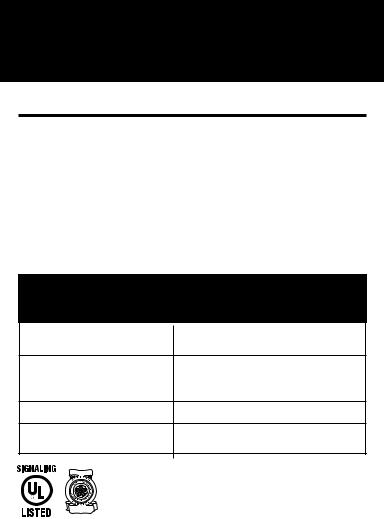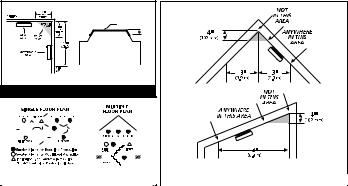Kidde P3010L User Manual

P3010H – Photoelectric Smoke Alarm w/ Safety Light P3010B – Photoelectric Smoke Alarm w/ Voice Alarm P3010L – Photoelectric Smoke Alarm
Smoke Alarm User’s Guide
Thank you for purchasing this Kidde Smoke Alarm. These models are battery operated Smoke Alarms which feature a non-replaceable, sealed-in battery and SMART HUSHTM Control to temporarily silence nuisance alarms.
Important: Please take a few minutes to thoroughly read this user’s guide which should be saved for future reference and passed on to any subsequent owner.
Teach children how to respond to the alarm and that they should never play with the unit.
Your Kidde Smoke Alarm was designed specifically for use in a residential environment. It is not designed for use in a recreational vehicle (RV) or boat.
For questions concerning your Smoke Alarm please call Product Support at 1-800-880-6788.
For your convenience, write down the following information. If you call Product Support, these are the first questions you will be asked.
Smoke Alarm Model Number:
(located on back of alarm)
Date Code: (located on back of alarm) The National Fire Protection Association (NFPA) and the manufacturer recommend replacing this alarm ten years from the date code.
Date of Purchase:
Where Purchased:
P/N: 0311-7201 RevA

WHAT TO DO WHEN THE ALARM SOUNDS
SMOKE ALARM ACTIVATION
Smoke alarm pattern is three long beeps repeating.
•Alert small children in the home as well as anyone else that might have difficulty recognizing the importance of the alarm sounding or that might have difficulty leaving the area without help.
•Leave immediately by your escape plan. Every second counts, so don’t waste time getting dressed or picking up valuables.
•In leaving, don’t open any inside door without first feeling its surface. If hot, or if you see smoke seeping through cracks, don’t open that door! Instead, use your alternate exit. If the inside of the door is cool, place your shoulder against it, open it slightly and be ready to slam it shut if heat and smoke rush in.
•Stay close to the floor if the air is smoky. Breathe shallowly through a cloth, wet if possible.
•Once outside, go to your selected meeting place and make sure everyone is there.
•Call the fire department from your neighbor’s home - not from yours!
•Don’t return to your home until the fire officials say that it is all right to do so.
•There are situations where a smoke alarm may not be effective to protect against fire as stated in the NFPA Standard 72. For instance:
a)smoking in bed
b)leaving children home alone
c)cleaning with flammable liquids, such as gasoline
•If the escape route requires you to go through smoke, crawl low under the smoke where the air is clearer.
CONTENTS OF THIS USER'S GUIDE
1 — LIMITATIONS OF SMOKE ALARMS
2 — RECOMMENDED LOCATIONS FOR ALARMS
3 — LOCATIONS TO AVOID
4 — INSTALLATION / MOUNTING INSTRUCTIONS
5 — OPERATION AND TESTING
6 — VISUAL AND AUDIBLE INDICATIONS
7 — NUISANCE AND HUSH
8 — BATTERY
9 — DEACTIVATION OF ALARM
10 — CLEANING
11 — GOOD SAFETY HABITS
12 — SERVICE AND WARRANTY
This alarm detects products of combustion using photoelectric technology.
This alarm is acceptable for use in all residential applications where smoke alarms are required.
After ten (10) years of cumulative power up, this unit will “chirp” two times every 30 seconds. This is an “operational end of life” feature which will indicate that it is time to replace the alarm.
To help identify the date to replace the unit, a label has been affixed to the side of the alarm. Write the “Replace by” date (10 years from initial power up) in permanent marker on the label prior to installing the unit.
Product Features and Specifications:
•Temperature: Operating Range: 40°F (4.4°C) to 100°F (37.8°C)
•Humidity: Operating range: 10-85% non-condensing
•Audible Alarm: 85+ dB at 10’ @ 3.4±0.5 KHz pulsing alarm
•Smoke Sensor: Photoelectric

1. LIMITATIONS OF SMOKE ALARMS
 WARNING: PLEASE READ CAREFULLY AND THOROUGHLY
WARNING: PLEASE READ CAREFULLY AND THOROUGHLY
•NFPA 72 states: Life safety from fire in residential occupancies is based primarily on early notification to occupants of the need to escape, followed by the appropriate egress actions by those occupants.
•Fire warning systems for dwelling units are capable of protecting about half of the occupants in potentially fatal fires. Victims are often intimate with the fire, too old or young, or physically or mentally impaired such that they cannot escape even when warned early enough that escape should be pos-
sible. For these people, other strategies such as protection-in-place or assisted escape or rescue are necessary.
•Smoke alarms are devices that can provide early warning of possible fires at a reasonable cost; however, alarms have sensing limitations. Ionization sensing alarms may detect invisible fire particles (associated with fast flaming fires) sooner than photoelectric alarms. Photoelectric sensing alarms may detect visible fire particles (associated with slow smoldering fires) sooner than ionization alarms. Home fires develop in different ways and are often unpredictable. For maximum protection, Kidde recommends that both Ionization and Photoelectric alarms be installed.
•A battery powered alarm must have a battery of the specified type, in good condition and installed properly.
•Smoke alarms must be tested regularly to make sure the battery and the alarm circuits are in good operating condition.
•Smoke alarms cannot provide an alarm if smoke does not reach the alarm.
Therefore, smoke alarms may not sense fires starting in chimneys, walls, on roofs, on the other side of a closed door or on a different floor.
•If the alarm is located outside the bedroom or on a different floor, it may not wake up a sound sleeper.
•The use of alcohol or drugs may also impair one’s ability to hear the smoke alarm. For maximum protection, a smoke alarm should be installed in each sleeping area on every level of a home.
This alarm is not intended to alert hearing impaired individuals.
ANYWHERE ALONG |
THIS BOLD SURFACE |
30.5 cm |
Locations permitted for smoke |
alarms and smoke detectors |
on tray-shaped ceilings. |
FIGURE 1 |
|
|
|
|
|
|
|
|
|
|
|
|
|
|
|
|
|
|
|
|
|
|
|
|
|
|
|
|
|
|
|
|
|
|
|
|
|
|
|
|
|
|
|
|
|
|
|
|
|
|
|
|
|
|
|
|
|
|
|
|
|
|
|
|
|
|
|
|
|
|
|
|
|
|
|
|
|
|
|
|
|
|
|
|
|
|
|
|
|
|
|
|
|
|
|
|
|
|
|
|
|
|
|
|
|
|
|
|
|
|
|
|
|
|
|
|
|
|
|
|
|
|
|
|
|
|
|
|
|
|
|
|
|
|
|
|
|
|
|
|
|
|
|
|
|
|
|
|
|
|
|
|
|
|
|
|
|
|
|
|
|
|
|
|
|
|
|
|
|
|
|
|
|
|
|
|
|
|
|
|
|
|
|
|
|
|
|
|
|
|
|
|
|
|
|
|
|
|
|
|
|
|
|
|
|
|
|
|
|
|
|
|
|
|
|
|
|
|
FIGURE 2 |
|
|
|
|
|
|
|
|
FIGURE 3 |
||||||
NFPA 72 states: “Smoke alarms in rooms with ceiling slopes greater than 1 ft in 8 ft (.3m in 2.4 m) horizontally shall be located on the high side of the room.” NFPA 72 states: “A row of detectors shall be spaced and located within 3 ft (0.9m) of the peak of the ceiling measured horizontally.”
2. RECOMMENDED LOCATIONS FOR ALARMS
•Locate the smoke alarms in all sleeping areas. Try to monitor the exit path as the bedrooms are usually farthest from the exit. If more than one sleeping area exists, locate additional alarms in each sleeping area.
•Locate additional alarms to monitor any stairway as stairways act like chimneys for smoke and heat.
•Locate at least one alarm on every floor level.
•Locate an alarm in every bedroom.
•Locate an alarm in every room where electrical appliances are operated
(i.e. portable heaters or humidifiers).
•Locate an alarm in every room where someone sleeps with the door closed. The closed door may prevent an alarm not located in that room from waking the sleeper.
•Smoke, heat, and combustion products rise to the ceiling and spread horizontally. Mounting the smoke alarm on the ceiling in the center of the room places it closest to all points in the room. Ceiling mounting is preferred in ordinary residential construction.
